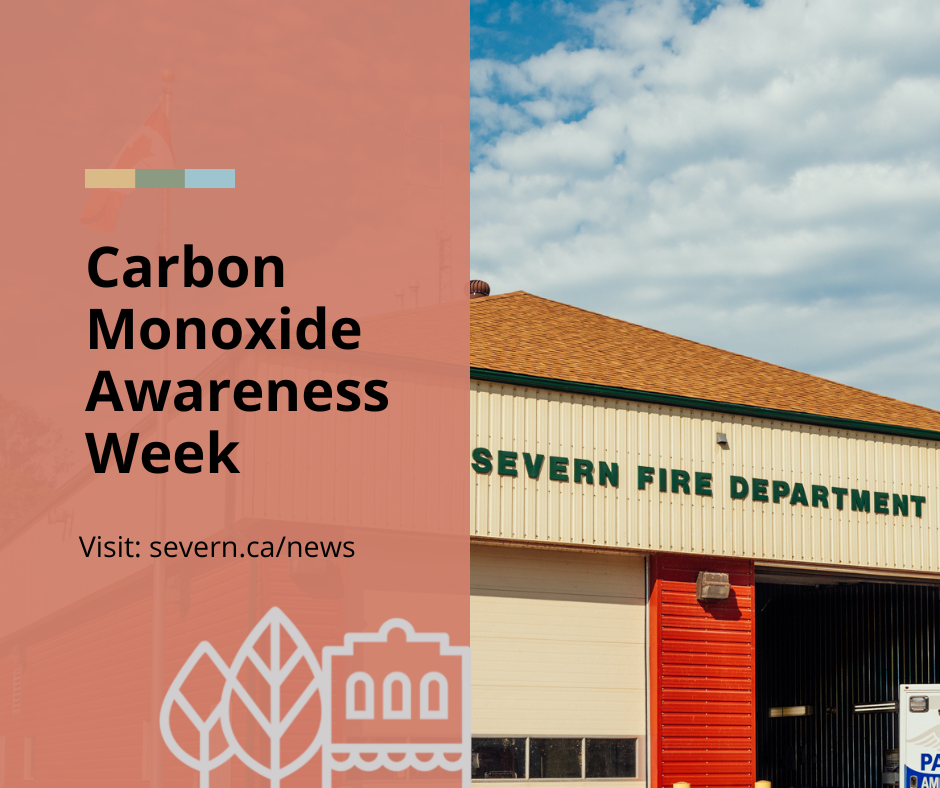Carbon Monoxide Awareness Week is November 1 to 7

Severn, Ontario: Ontario’s Carbon Monoxide Awareness Week runs from November 1 to 7, and Severn Fire and Emergency Services reminds you to prevent carbon monoxide (CO) in your home by getting all fuel-burning appliances inspected annually.
Carbon monoxide alarms are required in all Ontario homes that have a fuel-burning (wood, oil, natural gas, propane) appliance, fireplace or an attached garage. This includes indoor appliances that produce carbon monoxide such as furnaces, water heaters, stoves, dryers, and portable heaters. All fuel-burning appliances should be inspected regularly by a certified technician to check for leaks and ensure there is no build-up of carbon monoxide. Generators, barbeques, propane heaters, and other appliances that generate dangerous exhaust should always be used following the manufacturer's instructions.
Symptoms of exposure to carbon monoxide may be similar to the flu but without the elevated temperature. Known as the “silent killer,” exposure to carbon monoxide can cause headaches, nausea, dizziness, breathlessness, collapse, loss of consciousness and death.
"In Ontario, more than 65% of injuries and deaths from CO occur in the home. We want to make sure everyone is safe from CO. Have all fuel-burning appliances inspected by a registered contractor. Visit COSafety.ca to find a registered contractor near you."
Symptoms of exposure to carbon monoxide may be similar to the flu but without the elevated temperature. Known as the “silent killer,” exposure to carbon monoxide can cause headaches, nausea, dizziness, breathlessness, collapse, loss of consciousness and death.
"You must have a working CO alarm adjacent to each sleeping area of the home if your home has a fuel-burning appliance, a fireplace or an attached garage. For added protection, install a carbon monoxide alarm on every storey of the home according to the manufacturer’s instructions."
If you live in a condo or apartment building with a service room, CO alarms must be installed in the service room and outside of each sleeping area, and below and beside the service room. In condo or apartment buildings that have a garage, CO alarms must be installed adjacent to each sleeping area of all homes above, below and beside the garage. If you rent, the landlord is responsible by law for installing alarms and you must inform the landlord if the alarm is disconnected or not operating properly.
What is CO?
- CO is known as the silent killer because it is an invisible, tasteless and odourless gas that can be deadly
- CO is produced when fuels such as propane, gasoline, natural gas, heating oil or wood do not burn completely in fuel-burning appliances and devices, such as furnaces, gas or wood fireplaces, hot water heaters, stoves, barbeques, portable fuel-burning heaters and generators and vehicles
Prevent CO in your home
- ensure fuel-burning appliances, chimneys and vents are cleaned and inspected annually; visit COSafety.ca to find a registered contractor near you
- when cleaning wood burning appliances, coals and ash should be immediately removed from the home as they continue to generate CO while hot
- check that all outside appliance vents are not blocked
- gas and charcoal barbeques should only be used outside, away from all doors, windows, vents and other building openings; never use barbeques inside garages, even if the garage doors are open; remaining charcoal should be completed extinguished and cool before storing the appliance in a garage
- portable fuel-burning generators should only be used outdoors in well-ventilated areas away from windows, doors, vents, and other building openings and according to manufacturer’s instructions
- never use the stove or oven to heat your home
- open the flue before using a fireplace for adequate ventilation
- never run a vehicle or other fueled engine or motor inside a garage, even if the garage doors are open; always remove a vehicle from the garage immediately after starting it
- heating, ventilation and air conditioning systems should be serviced regularly to ensure fresh air is properly entering the home and exhausted gases are properly exiting; if the air is not properly being exchanged, any CO-producing appliances within the home could cause a buildup of CO over time
Know the symptoms of CO
- exposure to CO can cause flu-like symptoms such as headaches, nausea, dizziness, as well as confusion, drowsiness, loss of consciousness and death
- if your CO alarm sounds, and you or other occupants suffer from symptoms of CO poisoning, get everyone out of the home immediately; then call 911 or your local emergency services number from outside the building
- if your CO alarm sounds and no one is suffering from symptoms of CO poisoning, check to see if the battery needs replacing, or the alarm has reached its "end-of-life" before calling 911
Know the sound of your CO alarm
- your CO alarm sounds different than your smoke alarm; test both alarms monthly and make sure everyone in your home knows the difference between the two alarm sounds
- don’t be confused by the sound of your CO alarm’s low-battery warning; follow your CO alarm manufacturer’s instructions so you know the difference between the low-battery warning, the “end-of-life” warning, and the alarm alerting you to the presence of CO in your home
For more CO safety tips, visit the Office of the Fire Marshal and COsafety.ca.
-30-
Media contact
Tracy Roxborough
Communications Officer
Phone: 705-325-2315 x249
Email Tracy












